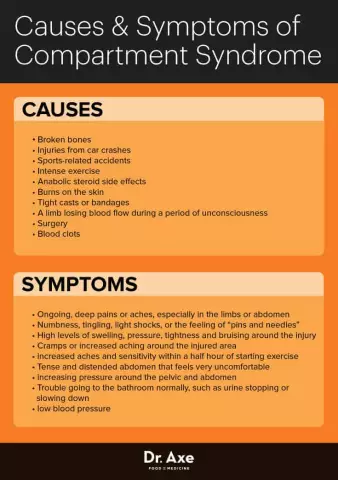- Author Rachel Wainwright [email protected].
- Public 2023-12-15 07:39.
- Last modified 2025-11-02 20:14.
Radicular syndrome

Neuralgic syndrome, which develops as a result of compression of the initial sections of the spinal nerves or nerve roots in the area of their branch from the spinal cord, in medicine is called radicular syndrome or radiculopathy. The painful sensations accompanying this pathology are localized in various parts of the human body, depending on the location of the lesion. So, pain can occur in the lower back, limbs, neck and even radiate to the area of internal organs, for example, to the stomach, heart, intestines.
Causes of radicular syndrome
Radicular syndrome is a very common disease and has many causes. The onset of the disease is primarily promoted by various degenerative diseases of the spine. Most often it is osteochondrosis, spondylosis, or intervertebral hernia. In addition, radicular syndrome can result from:
- All kinds of injuries and cicatricial changes;
- Osteoporosis (as a result of vertebral fractures);
- Osteomyelitis or tuberculosis (as a result of infectious vertebral damage);
- Changes in hormonal status;
- Spondyloarthrosis;
- Various congenital defects of the spine;
- Spinal cord cancer;
- Regular stress on the spinal column;
- Sedentary lifestyle;
- Hypothermia.
It should be noted that radicular syndrome does not occur immediately after exposure to one of the above reasons. As a rule, violations initially occur in the area of the intervertebral discs, which provokes the formation of hernias. After this, the hernia gradually shifts, starting to put pressure on the nerve root, which prevents the outflow of venous blood from it. This leads to the development of this disease.
Lumbar radicular syndrome
Most often, spinal radicular syndrome affects the lumbar region. This is due to the fact that this area, as a rule, experiences maximum stress in comparison with other parts of the spine. In addition, the muscles and ligaments of the lower back are relatively weak, and the holes for the exit of the nerve roots from the vessels are rather large.
With radicular lumbar syndrome, severe one-sided pain of a different nature is usually observed (aching, acute, dull, shooting, cutting, etc.). The nature of pain depends on the intensity of the damage to the nerve root and related factors. Attacks in this case can be triggered by sudden movements or hypothermia. Localization of pain is due to the defeat of specific roots of the lower back:
- Lumbar root syndrome, affecting 1-3 roots, is characterized by pain in the lower back, lower abdomen, front and inner thighs, in the groin and pubis. They are often accompanied by skin numbness and creeping sensations in these areas;
- With the defeat of the 4 lumbar roots, pain is observed in the lower back and hips, radiating to the knee and lower leg. With movements in the knee, noticeable weakness is felt;
- Radicular syndrome of the spine, affecting the 5th root of the lumbar spine, is manifested by pain in the area of the inner surface of the thighs and lower leg, reaching the foot and big toe. The muscles of the foot become weak, often resulting in difficulty standing on the affected foot.
It is worth noting that pain in the lumbar radicular syndrome usually stops or decreases at rest or when lying on a healthy side.
Radicular syndrome symptoms
The very first symptom of radicular syndrome is pain along the damaged nerve. So, if the disease affects the cervical region, then pain is observed in the neck and arms, chest - in the back, sometimes stomach or heart, lower back - in the lower back, buttocks and lower extremities. Almost any sudden, careless movement or heavy lifting can contribute to pain.
Along with this, often painful symptoms of radicular syndrome can make themselves felt at night during sleep, which is often accompanied by increased sweating, as well as swelling and redness of the skin. Hypothermia or emotional stress can also cause pain attacks.
Another common symptom of radicular syndrome is sensory disturbances in the area of the affected nerve. For example, tingling with a needle in this area is accompanied by a significant decrease in sensitivity compared to a similar procedure performed on the opposite healthy side.
In addition, an additional sign of radicular syndrome may be movement disturbance as a result of gradual weakness, drying out and muscle atrophy, which occurs due to damage to the nerves that innervate them.
Treatment of radicular syndrome
Diagnosis of the disease is carried out using a person's medical history, physical examination, anterior and lateral radiography of the spine, and magnetic resonance imaging. Treatment of radicular syndrome can be divided into the following methods:
- Bed rest;
- Drug therapy;
- Muscle relaxants;
- Chondroprotectors;
- Vitamins;
- Physiotherapy;
- Physiotherapy exercises and massages.

Medical treatment of radicular syndrome involves the use of pain relievers and non-steroidal anti-inflammatory drugs. The former are aimed at eliminating pain, the latter are aimed at relieving inflammation in the focus.
Muscle relaxants help relieve muscle spasms, and chondroprotectors slow down the destruction of cartilage in the intervertebral joints, activating the process of their recovery. Vitamins for the disease are aimed at improving metabolic processes in the nerve tissues, as well as maintaining the general condition of the patient.
Treatment of radicular syndrome with physiotherapy may include radon baths, magnetotherapy, mud therapy, ultrasound, etc. However, physiotherapy is usually applied after the acute period of the disease.
Physiotherapy exercises and massages for the syndrome strengthen the muscles of the spine, improve blood circulation and restore the patient's motor activity. In the most severe cases of the disease, surgery may be necessary.
YouTube video related to the article:
The information is generalized and provided for informational purposes only. At the first sign of illness, see your doctor. Self-medication is hazardous to health!






